Themed collection Chirality at the nanoscale

Chiral nanostructure in polymers under different deposition conditions observed using atomic force microscopy of monolayers: poly(phenylacetylene)s as a case study
Techniques used for the study of the secondary structure of polymers by means of atomic-force microscopy are evaluated.
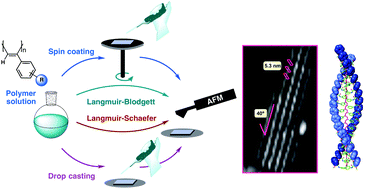
Chem. Commun., 2017,53, 481-492
https://doi.org/10.1039/C6CC05598B
Simple rules and the emergence of complexity in surface chirality
Surface chirality arising from self-organized molecular monolayers may manifest both a handedness and footedness, leading to a dual level of chiral expression.
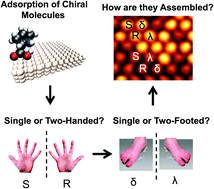
Chem. Commun., 2016,52, 14075-14084
https://doi.org/10.1039/C6CC06523F
Nanoscale chirality in metal and semiconductor nanoparticles
We discuss optical activity in metal nanoclusters and semiconductor quantum dots, broadly focusing on recent advances in nanoscale chirality in plasmonic nanoparticles and their assemblies.

Chem. Commun., 2016,52, 12555-12569
https://doi.org/10.1039/C6CC05613J
Chiral expression of adsorbed (MP) 5-amino[6]helicenes: from random structures to dense racemic crystals by surface alloying
The chiral expression of a molecule on a surface is driven from a random solid solution on Cu(100) to a racemic crystal on a Sn/Cu(100) alloy.
![Graphical abstract: Chiral expression of adsorbed (MP) 5-amino[6]helicenes: from random structures to dense racemic crystals by surface alloying](/is/Image/Get?imageInfo.ImageType=GA&imageInfo.ImageIdentifier.ManuscriptID=C6CC06785A&imageInfo.ImageIdentifier.Year=2017)
Chem. Commun., 2017,53, 130-133
https://doi.org/10.1039/C6CC06785A
Direct observation of the influence of chirality on the microstructure of regioregular poly(3-alkylthiophene)s at the liquid/solid interface
The chirality of alkyl side chains has a significant impact on the microstructures of regioregular poly(3-alkylthiophene)s.
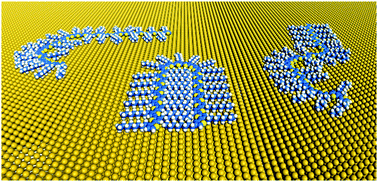
Chem. Commun., 2017,53, 153-156
https://doi.org/10.1039/C6CC08074J
Chiral nanoscale pores created during the surface explosion of tartaric acid on Cu(111)
The autocatalytic decomposition of tartaric acid on Cu(111) exhibits unique kinetics, which are linked to a hexagonal surface structure adopted at high coverage.
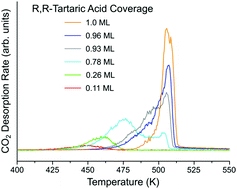
Chem. Commun., 2016,52, 14282-14285
https://doi.org/10.1039/C6CC05820E
Explosive enantiospecific decomposition of aspartic acid on Cu surfaces
R- and S-enantiomorphs of the Cu(643) surface catalyze the enantiospecific explosive decomposition of D- and L-aspartic acid.
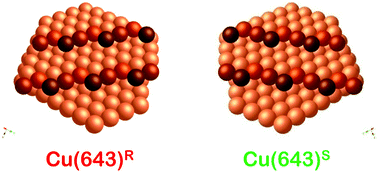
Chem. Commun., 2016,52, 14125-14128
https://doi.org/10.1039/C6CC06887A
Selection of conformational states in surface self-assembly for a molecule with eight possible pairs of surface enantiomers
Chiral adsorption of a complex molecule with as many as eight possible pairs of surface enantiomers is investigated by STM and the selection of enantiomers is understood by statistical analysis and DFT modelling.

Chem. Commun., 2016,52, 14023-14026
https://doi.org/10.1039/C6CC06876F
Mirror symmetry breaking in cubic phases and isotropic liquids driven by hydrogen bonding
Achiral hydrogen bonded rod-like complexes with four nonequally distributed terminal alkyl chains form a chirality synchronized isotropic liquid conglomerate as well as a conglomerate type chiral cubic phase.
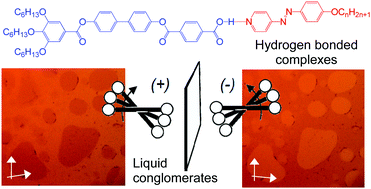
Chem. Commun., 2016,52, 13869-13872
https://doi.org/10.1039/C6CC08226B
Chiral supramolecular organization and cooperativity in DNA-templated assemblies of ZnII–chromophore complexes
Templated cooperative binding induced assembly of chromophores is achieved via interactions between Zn-complexes and the DNA phosphodiester backbone.
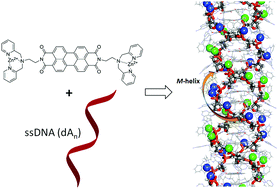
Chem. Commun., 2016,52, 13873-13876
https://doi.org/10.1039/C6CC07414F
Tuning the structure of 1,3,5-benzene tricarboxamide self-assemblies through stereochemistry
A heterochiral BTA monomer forms long rods in cyclohexane whilst its homochiral analogue assembles into dimers.

Chem. Commun., 2016,52, 13369-13372
https://doi.org/10.1039/C6CC07325E
Vortexes tune the chirality of graphene oxide and its non-covalent hosts
The ability of vortexes to tune the chirality of graphene oxide in water sheds light on its complex supramolecular organization allowing for selective noncovalent deposition of a predetermined handedness on a solid surface.

Chem. Commun., 2016,52, 13094-13096
https://doi.org/10.1039/C6CC05177D
Surface-assisted diastereoselective Ullmann coupling of bishelicenes
A surface induces diastereoselectivity in Ullmann coupling of bromohelicenes.

Chem. Commun., 2016,52, 12694-12697
https://doi.org/10.1039/C6CC05849C
Directing the Viedma ripening of ethylenediammonium sulfate using “Tailor-made” chiral additives
Viedma ripening of ethylenediammonium sulfate can be directed with chiral 1,2-diammonium sulfate derivatives according to the “rule-of-reversal”.

Chem. Commun., 2016,52, 12626-12629
https://doi.org/10.1039/C6CC06534A
Anion size control of the packing in the metallic versus semiconducting chiral radical cation salts (DM-EDT-TTF)2XF6 (X = P, As, Sb)
Tuning of the structural type and conducting properties have been achieved through chirality of the precursor and anion size.

Chem. Commun., 2016,52, 12438-12441
https://doi.org/10.1039/C6CC06706A
Chiral signs of TPPS co-assemblies with chiral gelators: role of molecular and supramolecular chirality
The chirality of TPPS J aggregates followed the supramolecular chirality of assemblies from chiral molecules rather than the molecular chirality.

Chem. Commun., 2016,52, 12434-12437
https://doi.org/10.1039/C6CC05668G
Magnesium plasmonics for UV applications and chiral sensing
We demonstrate that chiral magnesium nanoparticles show remarkable plasmonic extinction- and chiroptical-effects in the ultraviolet region.
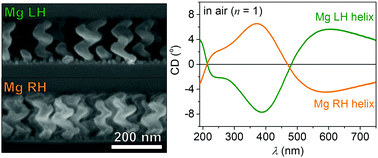
Chem. Commun., 2016,52, 12179-12182
https://doi.org/10.1039/C6CC06800F
First-order hyperpolarizabilities of chiral, polymer-wrapped single-walled carbon nanotubes
Manipulation of polymer electronic structure provides a new means to modulate the first-order hyperpolarizabilities (βHRS values) of chiral, individualized polymer-wrapped single-walled carbon nanotube superstructures at a telecommunication-relevant wavelength (1280 nm).

Chem. Commun., 2016,52, 12206-12209
https://doi.org/10.1039/C6CC06190G
Speeding up Viedma ripening
Using the conversion of a metastable racemic compound into the conglomerate, fast deracemization of two amino acid derivatives was achieved.
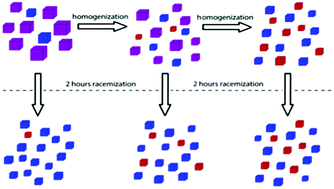
Chem. Commun., 2016,52, 12048-12051
https://doi.org/10.1039/C6CC06766B
Chiral templating of alumina nanofilms by the atomic layer deposition process
The overall synthesis of novel chiral nanosized metal-oxide nanofilms and surfaces, based on the chiral templating of cellulose with alumina using the atomic layer deposition process.

Chem. Commun., 2016,52, 12072-12075
https://doi.org/10.1039/C6CC05892B
Manifesting the sergeants-and-soldiers principle in coadsorber induced homochiral polymorphic assemblies at the liquid/solid interface
Strong hydrogen bonding facilitates a more efficient amplification of chirality because of its critical role in chiral communication.

Chem. Commun., 2016,52, 12088-12091
https://doi.org/10.1039/C6CC05799C
Helix–helix inversion of an optically-inactive π-conjugated foldamer triggered by concentration changes of a single enantiomeric guest leading to a change in the helical stability
An optically-inactive foldamer undergoes helicity induction and subsequent helix-inversion with the increasing amount of a single enantiomeric guest.

Chem. Commun., 2016,52, 11752-11755
https://doi.org/10.1039/C6CC05753E
Oriented attachment by enantioselective facet recognition in millimeter-sized gypsum crystals
Optical crystallography of precipitated hot supersaturated solutions of calcium sulphate shows oriented attachment of gypsum crystals at homochiral facets.

Chem. Commun., 2016,52, 11673-11676
https://doi.org/10.1039/C6CC06353E
Chiral and fractal: from simple design rules to complex supramolecular constructs
The surface-confined self-assembly of K- and A-shaped molecular bricks with carefully adjusted size and functionality into fractal aggregates is demonstrated using theoretical modeling.

Chem. Commun., 2016,52, 11642-11645
https://doi.org/10.1039/C6CC05348C
The role of counter-anions in the kinetics and chirality of porphyrin J-aggregates
The structure-making or breaking abilities of different anions, according to the Hofmeister series, play an important role in controlling the kinetics of growth and the chirality in porphyrin J-aggregates.

Chem. Commun., 2016,52, 11520-11523
https://doi.org/10.1039/C6CC05768C
A chiroptical molecular sensor for ferrocene
A chiral molecular sensor is used to recognize ferrocene, with the chiroptical readout used selectively in the presence of competing analytes.

Chem. Commun., 2016,52, 11492-11495
https://doi.org/10.1039/C6CC05937F
Influence of step faceting on the enantiospecific decomposition of aspartic acid on chiral Cu surfaces vicinal to Cu{111}
The crystallographic orientation of chiral step facets created by L-aspartic acid adsorption dictates enantioselectivity on chiral surfaces vicinal to Cu{111}.
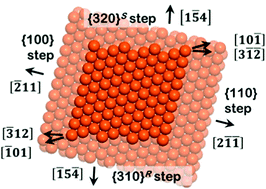
Chem. Commun., 2016,52, 11263-11266
https://doi.org/10.1039/C6CC05957K
Reversible and irreversible emergence of chiroptical signals in J-aggregates of achiral 4-sulfonatophenyl substituted porphyrins: intrinsic chirality vs. chiral ordering in the solution
Different origins of the reversible and irreversible emergence of chiroptical signals in the title J-aggregates.
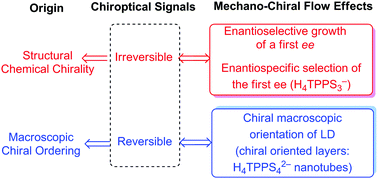
Chem. Commun., 2016,52, 10874-10877
https://doi.org/10.1039/C6CC05709H
Consequences of conformational flexibility in hydrogen-bond-driven self-assembly processes
Chiral, conformationally flexible C3-symmetrical trisamides self-assemble into helical aggregates but a helical bias is only expressed in linear alkane solvents and not in cyclic ones.

Chem. Commun., 2016,52, 10870-10873
https://doi.org/10.1039/C6CC05593A
Chiral recognition at self-assembled multivalent (SAMul) nanoscale interfaces – enantioselectivity in polyanion binding
We investigate structure–activity effect relationships at the nanoscale chiral molecular recognition interface between enantiomeric self-assembled multivalent (SAMul) systems and biological polyanions, heparin and DNA.

Chem. Commun., 2016,52, 10540-10543
https://doi.org/10.1039/C6CC04470K
Dual electrically and thermally responsive broadband reflectors based on polymer network stabilized chiral nematic liquid crystals: the role of crosslink density
An adjustable broadband reflector based on a polymer stabilized chiral nematic liquid crystal has been fabricated.

Chem. Commun., 2016,52, 10109-10112
https://doi.org/10.1039/C6CC04721A
Well-defined, persistent, chiral phthalocyanine nanoclusters via G-quadruplex assembly
Monodisperse nanoclusters are produced via G-quadruplex assembly with potassium salts in which red-absorbing phthalocyanine dyes are arranged in a well-defined chiral organization.

Chem. Commun., 2016,52, 9446-9449
https://doi.org/10.1039/C6CC04152C
About this collection
We are delighted to present this web theme celebrating current achievements and future perspectives in the exciting field of chirality at the nanoscale. Guest edited by Steven De Feyter (KU Leuven), Thierry Verbiest (KU Leuven), Roberto Lazzaroni (Université de Mons), and David Amabilino (University of Nottingham), this themed collection covers all aspects of nanoscale chirality, including synthesis of chiral nanostructures, physicochemical characterization, enantiospecific separation, chiral catalysis, molecular recognition, optical properties, chiral surfaces, self-assembly, molecular machines and switches, theory, and other topics. New articles will be added to this collection as they are published.